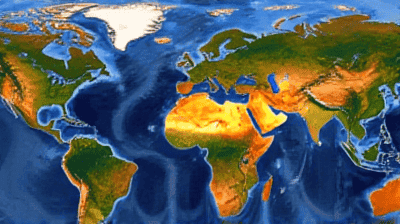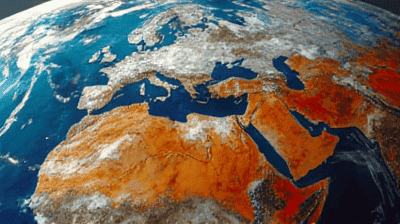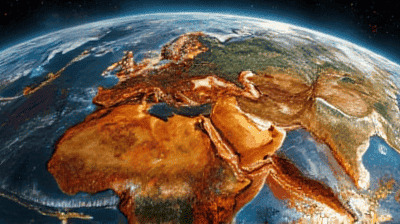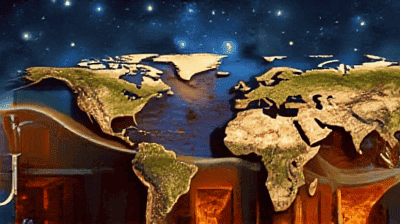
The Earth is a dynamic planet, undergoing constant change driven by various geological processes. At the heart of these processes lies the theory of plate tectonics, which explains how the continents and ocean floors move and evolve over geological time. This theory not only sheds light on the formation of mountains, earthquakes, and volcanic activity but also helps us understand the very structure of our planet.
Plate tectonics is a scientific theory that describes the large-scale movements of the Earth's lithosphere, which is the rigid outer layer of the Earth. This lithosphere is broken into tectonic plates that float on the semi-fluid asthenosphere beneath. These tectonic plates vary in size and can be composed of both continental crust and oceanic crust.
Lithosphere: The lithosphere comprises the Earth's crust and the uppermost part of the mantle. It is rigid and brittle, and it is divided into tectonic plates.
Asthenosphere: Beneath the lithosphere lies the asthenosphere, a layer of the mantle that behaves like a viscous fluid over geological time. The asthenosphere allows tectonic plates to move.
Tectonic Plates: The Earth's lithosphere is divided into several major and minor plates, including:

The theory of plate tectonics evolved from earlier geological theories and discoveries. Understanding the historical context of this theory is crucial for appreciating its significance in geology.
In the early 20th century, German meteorologist Alfred Wegener proposed the theory of continental drift, suggesting that continents were once part of a single supercontinent called Pangaea, which broke apart and drifted to their current positions.
Despite these compelling pieces of evidence, Wegener's ideas were not widely accepted during his lifetime, as he could not explain the mechanism for continental movement.
The development of plate tectonics as a comprehensive theory occurred in the mid-20th century, thanks to advancements in numerous scientific fields, including geology, seismology, and oceanography.
Seafloor Spreading: The discovery of mid-ocean ridges and the concept of seafloor spreading revolutionized our understanding of tectonics. In the 1960s, scientists such as Harry Hess proposed that new oceanic crust forms at mid-ocean ridges and moves outward, causing continents to drift apart.
Magnetic Reversals: Studies of magnetic anomalies on the ocean floor revealed patterns of symmetrical stripes on either side of mid-ocean ridges, corresponding to periodic reversals of the Earth's magnetic field. This discovery provided further evidence for seafloor spreading.
Plate Boundaries: Scientists identified three types of plate boundaries where tectonic plates interact:
The integration of these concepts into a cohesive framework solidified plate tectonics as the unifying theory of geology.
Tectonic plates move due to various processes driven by heat from the Earth's interior. Understanding these processes is essential for appreciating how continents drift and shape the Earth's surface.
The Earth's mantle, located beneath the lithosphere, is in a constant state of convection. This process involves the transfer of heat from the Earth's core to the surface, leading to the formation of convection cells.
Two primary forces contribute to the movement of tectonic plates:
Slab Pull: When an oceanic plate collides with a continental plate at a convergent boundary, the denser oceanic plate sinks into the mantle, pulling the rest of the plate along with it. This process is known as slab pull and is a major driver of plate movement.
Ridge Push: At divergent boundaries, new crust is formed at mid-ocean ridges, pushing older crust away from the ridge. This creates a force known as ridge push, which contributes to the movement of tectonic plates.
Gravitational forces also play a role in plate tectonics. The weight of tectonic plates causes them to sink into the mantle at subduction zones, while the buoyancy of continental crust can elevate land masses above sea level.

The interactions between tectonic plates occur primarily at their boundaries, leading to various geological phenomena, including earthquakes, volcanic activity, and mountain formation. There are three main types of plate boundaries:
At divergent boundaries, tectonic plates move apart, leading to the creation of new crust. Key characteristics include:
Mid-Ocean Ridges: These underwater mountain ranges, formed by the upwelling of magma, are found at divergent boundaries in the ocean.
Rift Valleys: Continental rifts occur when a continent is pulled apart, forming low-lying areas known as rift valleys. An example is the East African Rift.
Volcanic Activity: As magma rises to fill the gap left by the diverging plates, it can lead to volcanic eruptions along the mid-ocean ridges.
At convergent boundaries, tectonic plates collide, leading to significant geological activity. Several scenarios can occur:
Subduction Zones: When an oceanic plate collides with a continental plate, the denser oceanic plate is forced beneath the continental plate into the mantle, creating a subduction zone. This process leads to intense volcanic activity, deep ocean trenches, and mountain ranges.
Continental Collision: When two continental plates collide, both plates can crumple and fold, resulting in the formation of mountain ranges. The Himalayas, formed by the collision of the Indian Plate and the Eurasian Plate, are a prime example.
Earthquakes: The immense stress and friction at convergent boundaries often lead to powerful earthquakes. The energy released during these events can be devastating, especially in populated areas.
At transform boundaries, tectonic plates slide past one another horizontally. Key characteristics include:
Fault Lines: The friction between sliding plates can cause the formation of fault lines, with the San Andreas Fault in California being one of the most famous examples.
Earthquake Generation: The movement of plates along transform boundaries can result in frequent earthquakes. The energy released during these events is typically localized but can be powerful.
Plate tectonics plays a significant role in shaping the Earth's surface, influencing landscapes, ecosystems, and even climate. Key impacts include:
The collision of tectonic plates leads to the formation of mountain ranges. As plates converge, their edges buckle and fold, creating high peaks and ridges. This process is known as orogeny. Notable examples of mountain ranges formed by tectonic activity include:
The Himalayas: Formed by the ongoing collision of the Indian Plate and the Eurasian Plate, the Himalayas contain the highest peaks on Earth, including Mount Everest.
The Andes: This mountain range in South America is formed by the subduction of the Nazca Plate beneath the South American Plate, leading to volcanic activity along the way.
The movement of tectonic plates generates stress at their boundaries, leading to earthquakes. The intensity and frequency of these seismic events vary based on the type of plate boundary involved:
Convergent Boundaries: Earthquakes along subduction zones can be particularly powerful and are often associated with tsunamis.
Transform Boundaries: Transform boundaries, where plates slide past one another, are also prone to significant seismic activity.
Plate tectonics is responsible for much of the volcanic activity on Earth. Understanding the relationship between tectonic processes and volcanism is essential for predicting volcanic eruptions. Key volcanic settings include:
Mid-Ocean Ridges: Volcanic activity at divergent boundaries forms new oceanic crust and contributes to the growth of underwater mountains.
Subduction Zones: The melting of subducted plates generates magma, leading to the formation of volcanic arcs, such as the Cascade Range in the United States.
Hot Spots: Some volcanic activity occurs away from plate boundaries in areas known as hot spots, where hot mantle plumes rise to create volcanoes. The Hawaiian Islands are an example of volcanic islands formed by a hot spot.

Plate tectonics affects not only geological features but also the Earth's climate and ecosystems:
The distribution of continents and ocean basins directly influences ocean currents and atmospheric circulation, which play crucial roles in shaping the Earth's climate:
Continental Drift: As continents shift over geological time, they can alter oceanic and atmospheric patterns, leading to changes in climate.
Mountain Formation: The uplift of mountain ranges can affect local climates by blocking moisture-laden winds, resulting in rain shadows and diverse ecosystems.
The movement of tectonic plates shapes habitats and contributes to the evolution of species:
Isolation: The separation of landmasses can lead to the isolation of species, fostering biodiversity through processes such as adaptive radiation.
Habitat Formation: Geological processes, including volcanic eruptions and the creation of new landforms, create diverse habitats that support a variety of life forms.
Understanding plate tectonics has significant implications for society today. By studying tectonic activity, scientists can:
The study of plate tectonics is essential for assessing and mitigating the risks associated with natural hazards such as earthquakes, tsunamis, and volcanic eruptions:
Earthquake Preparedness: By identifying seismic risk areas and understanding the mechanisms driving earthquakes, communities can implement preparedness measures, such as building codes and emergency response plans.
Tsunami Warning Systems: Monitoring tectonic activity and seismic events allows for the development of tsunami warning systems, providing critical information to coastal communities.
The study of tectonic processes can inform resource exploration, including oil, gas, and mineral resources:
Petroleum Geology: Understanding the geological conditions created by tectonic processes aids in locating potential oil and gas reserves.
Geothermal Energy: Regions near tectonic plate boundaries often have geothermal activity, presenting opportunities for renewable energy development.
Understanding plate tectonics continues to be a dynamic area of research, with several promising directions for the future:
The use of advanced technologies, such as satellite monitoring and GPS, allows scientists to study plate movements in real-time:
Geodesy: High-precision measurements of the Earth's surface through GPS and radar interferometry enable researchers to monitor tectonic plate movements and deformation.
Remote Sensing: Satellite imagery and remote sensing techniques can provide valuable data on tectonic features and volcanic activity.
Exploring the interactions between tectonic processes and climate change is an emerging field of research, offering insights into long-term environmental changes:
Paleoceanography: Studying ancient oceanic and atmospheric conditions can improve our understanding of how tectonic changes have influenced climate over geological time scales.
Impact on Biodiversity: Research into how tectonic processes shape ecosystems and biodiversity is critical for conservation efforts and understanding species evolution.
Plate tectonics is a fundamental theory that explains the dynamic processes shaping the Earth's surface. By understanding how tectonic plates move and interact, we can better comprehend the geological features, natural hazards, and environmental changes that influence our planet. From the formation of mountains and earthquakes to the impact on climate and biodiversity, plate tectonics plays a crucial role in the Earth's geological history and present-day challenges. As research continues, new technologies and insights will deepen our understanding of this complex and fascinating subject, helping us to navigate the challenges and opportunities presented by our ever-changing planet.